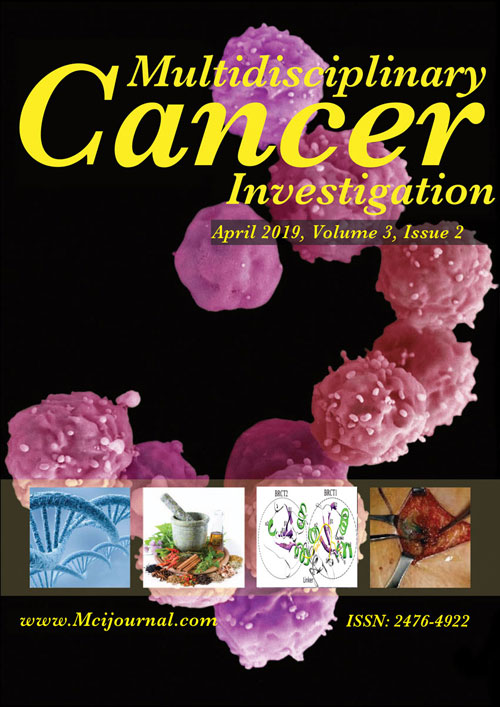فهرست مطالب

Multidisciplinary Cancer Investigation
Volume:3 Issue: 2, Apr 2019
- تاریخ انتشار: 1398/01/22
- تعداد عناوین: 3
-
-
Pages 5-13In the electromagnetic spectrum, structural damage to living tissues per unit of absorbed energy tends to increase with the decrease of a wavelength which is evident not only for ultraviolet and ionizing radiation but also for the infrared and visible light. By causing thermal damage after absorbing energies that would be harmless for radiofrequency electromagnetic fields (EMF), tissues are evenly heated. There are no prima facie reasons to expect more damage from EMF than from infrared radiation which is believed to be harmless in terms of thermal damage. Several studies reported possible associations between EMF, glioma and other tumors. Other research did not confirm such associations or even identified a reduced risk of brain tumors among mobile phone (MP) users. Anelevation in the application of MP has been observed in some countries and age groups which is out of proportion. Improving imaging technology and access to health care units have contributed to an increased incidence rate. Bias is known to occur in epidemiologic research. At the beginning of the MP era, the use of MP was associated with a high income which, in turn, must be associated with better diagnostics results. Admittedly, nowadays MPs are affordable for the majority of people and it is unclear whether the socioeconomic bias still plays a significant role. In conclusion, there is neither compelling evidence nor theoretic plausibility for the concept that EMF is more harmful than infrared radiation per unit of absorbed energy.Keywords: Electromagnetic Fields, Cell Phone, Neoplasms
-
Pages 14-19IntroductionStreptomyces manage the osmotic stress by collecting compatible solutes or osmolytes. Ectoine, 1,4,5,6-tetrahydro-2-methyl-4-pyrimidine carboxylic acid, and 5-hydroxyectoine are among the most common osmolytes of this bacteria and have an active role in protecting the genetic material of this microorganism as well as providing resistance to environmental pressures. In this research, the antiproliferative and apoptotic effects of ectoine and 5- hydroxyectoine on human non-small cell lung cancer (NSCLC) cell line (QU-DB) are investigated.MethodsQU-DB cells were treated by five doses of ectoine and hydroxyectoine for 12, 24 and 48 hours, and the cytotoxic properties were evaluated by MTT assay. Then, the DAPI fluorescent staining was carried out for monitoring of the cells’nuclear morphology. Recognition and quantification of the apoptosis were done; using the Annexin-V-Fluos technique.ResultsIt has been verified that both ectoine and hydroxyectoine persuaded apoptosis on QU-DB cells in a dose-dependently manner.ConclusionsEctoine and hydroxyectoine are two natural metabolites which induce apoptosis in lung cancer cells. They don’t have any toxic effect on normal cells and can be used as auxiliary drugs or even as a medicine for the treatment of lung cancer after further optimization of the formulations.Keywords: Ectoine, Hydroxyectoine, Lung Cancer Cells
-
Pages 20-26IntroductionMutations in the BRCA1 gene are major risk factors for breast and ovarian cancers. However, the relationship between some BRCA1 mutations and cancer risk remains largely unknown. Cancer risk predictions could be improved by evaluation of the impairment degree in the BRCA1 functions due to a specific mutation. This study aimed to assess the functional effect of a novel variant (Glu1661Gly) by a combination of in silico tools, structural analysis, and also experimental functional assay based on yeast transcription activation.MethodsComputational tools including PROVEAN, PolyPhen2, Align-GVGD, Mutation Taster, and also structural analysis were used for prediction of the impact of Glu1661Gly on protein function. To perform the yeast functional assay, the BRCA1 C-terminal (BRCT domain) was cloned into pLexA plasmid in-frame with the DNA-binding domain of LexA to generate a functional transcription activator. The resulted construct was transformed into EGY48/ pRB1840 yeast and positive colonies were assayed for β-galactosidase activity. Wild-type BRCA1 and Ser1613Gly were used as positive controls and Met1775Arg as negative control.ResultsThe Glu1661Gly variant was predicted to be neutral by PROVEAN, disease- causing by Mutation Taster, probably damaging by Polyphen2, and intermediate effect by Align-GVGD. The yeast functional assay revealed that Glu1661Gly activity was comparable to wild-type BRCA1ConclusionsObserved discrepancies between in silico tools make it difficult to interpret the results. Based on structural analysis, the Glu1661Gly on α1 helix of the C-terminal domain does not seem to impair function due to α1 helix is far from the BRCT-BRCT interface and phosphopeptide-binding site. This variant was also classified as neutral; using yeast functional assay.Keywords: Susceptibility Genes, BRCA1, VUS, Glu1661Gly, Transcriptional Activation

